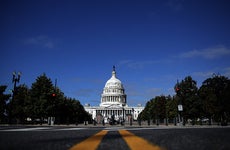Stimulus checks: What consumers should consider doing with the money

The Bankrate promise
At Bankrate we strive to help you make smarter financial decisions. While we adhere to strict , this post may contain references to products from our partners. Here's an explanation for .
A new round of COVID-19 financial relief is finally on its way to help millions of struggling Americans get through tough times caused by the coronavirus crisis.
A massive $1.9 trillion package with a third stimulus check and additional help for people who are unemployed has passed. As a result, many Americans will receive a $1,400 stimulus check or more.
During these difficult and uncertain times, you might need the cash to pay for essentials, like food or bills. If you already have some cushion, you will want to consider ways to use the money to better position yourself.
“I would be looking at ways that we can buy ourselves some breathing space, some margin,” says Charlie Bolognino, ChFC, CFP, and owner of Side-by-Side Financial Planning LLC in Plymouth, Minnesota.
Here are seven tips about where to allocate stimulus money and maximize these funds.
1. Strategize before spending
Before spending any of the money, formulate a plan and start with the necessities.
As Bolognino sees it, the first building block is making sure your foundation is strong: You might need this cash for food, supplies and critical bills. If you can afford to do so, save some of the money for the weeks ahead and the next round of bills.
Around 2008, Elizabeth Buffardi was unemployed for 13 months. During this experience, the certified financial planner at Crescendo Financial Planners in Oak Brook, Illinois, needed to make her money last. So, she whipped up a strategy to really take a hard look at where she was spending her money to stay afloat. Now, she recommends that approach to others.
“You have to figure out how you’re going to make it last as long as you possibly can,” Buffardi says.
She recommends not just looking at whether you have income coming in, but also considering your cash levels in an emergency fund or money in other liquid accounts.
2. Catching up on past due bills
The pandemic has been difficult for a lot of people. While some consumers have taken advantage of student loan federal forbearance and mortgage forbearance, the relief can only help individuals who have lost their incomes so much.
Reach out to the companies or banks where you have a past due bill. See whether you can make a minimum payment to stay current. By taking this step, hopefully it will help prevent the past due bill from affecting your credit history.
You’d like to pay all of your bills. But in this emergency situation, make sure you’re prioritizing your payments to food, utilities and shelter since income might be limited.
3. Fund an emergency savings account
If you can afford to do so, put some of this money into an emergency fund, whether it’s an existing fund or one you’re starting from scratch.
“The first priority is to pad your emergency savings,” says Greg McBride, CFA, Bankrate chief financial analyst. “Even if the money isn’t needed right away, having it available if needed later is a financial buffer and provides some peace of mind.”
Since this check might be larger than previous stimulus checks you’ve received and your job situation may have also recently improved, there may be an increased opportunity to save a portion of this check for future emergencies.
4. Make a new budget
No one knows how long it will take for America to get back to normal, which means you will want to stretch your stimulus check as much as possible. Having a budget is the best way to navigate where your money is going. If you already have a budget, you will want to reevaluate it. The world is different than it was a year ago.
“We’re not going to the show, we’re not going to this or that,” Bolognino says.
A budget will help you make smarter spending decisions, including potentially cutting certain services or subscriptions.
5. Pay off high-interest credit-card debt
In a Bankrate survey conducted in January, fewer than 4 in 10 U.S. adults (39 percent) could cover the cost of a $1,000 car repair or emergency room visit using their savings.
Not receiving a paycheck and still having to purchase necessities for an unplanned emergency is bound to make some people use their credit cards for these purchases. If you fall into this group, try to pay the bill as soon as it’s due or as soon as possible.
Use some of the money from the stimulus checks to pay your bills (or a portion of them) that accumulated during the period of time that your unemployment started, if applicable.
6. A balance-transfer credit card may buy you some time
Zero percent annual percentage rate (APR) offers or balance transfer credit cards may be an option for those needing low-interest or interest-free relief.
Before taking any offer, make sure you understand the balance transfer fees or other fees that you might incur. Also check the terms and conditions of this offer to see whether interest on new purchases may accumulate at a different APR than your promotional one.
Be mindful to only transfer or spend an amount that you’re certain you’ll be able to pay off when the promotional period ends. Otherwise, this decision can lead to long-term debt.
7. Make sure your money is earning a competitive yield
Every penny means even more right now. That’s why savings sitting in an account near the national average of 0.07 percent annual percentage yield (APY) needs to be in a liquid account that earns a higher yield.
Rates have dropped since last March, but online banks tend to offer more competitive yields than traditional banks on savings accounts and money market accounts. Compare rates on Bankrate to find the right account for a portion of your stimulus check.
Making smart financial decisions
For many Americans, these are tough times. But making thoughtful spending choices and assessing your needs and wants can help make the dollars you have last longer. That’s especially vital in cases where you don’t have income and/or an emergency fund to use.
“A monthly-spending plan is tailor-made for this scenario,” Bolognino says.
Learn more:
- How to save $1,200 in 12 months to fund an emergency instead of relying on stimulus checks
- Pandemic movers sought affordability, but not too far away, USPS data shows
- What to do if you can’t pay your loans during the coronavirus crisis
Related Articles


Coronavirus relief and stimulus plans: Here’s everything Washington has done (and proposed) so far

Second stimulus check and extended unemployment benefits? Here’s what aid could be on the way
